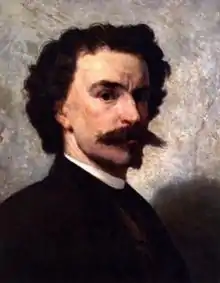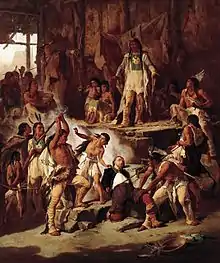Victor Nehlig
Victor Nehlig (1830, Paris – 1909, New York City) was a French-American painter.



Life
Born in Paris in 1830, Nehlig studied painting under Léon Cogniet and Abel de Pujol. In 1850, he moved to the United States, where he would live and work for the next 22 years, interrupted only by a brief stay in Havana, Cuba. During his time in the United States, Nehlig opened a studio in New York City and painted a variety of works in the academic style, often demonstrating his prowess at depicting the human figure. Nehlig returned to his native France in 1872, two years after being elected an academician in the National Academy of Design and shortly after his studio and many of his reference materials were destroyed in a devastating fire.[1] He died in 1909 in New York City.[2]
Works
While Nehlig was relatively well known among art enthusiasts during his time, his work has seen less attention in subsequent years.[3] He frequently painted interpretations of American history, taking a special interest in scenes from the American Civil War, the effects of which he witnessed firsthand. An Episode of the War — The Cavalry Charge of Lt. Henry B. Hidden (1875), held in the collection of the New-York Historical Society's Henry Luce III Center for the Study of American Culture, and Pocahontas Saving Capt. John Smith (1870), held in the collection of the Museum of Art BYU, are among his only paintings on public display. A number of others exist in private collections.
References
- Hale, Edward Everett (1872). Old and New. London: Sampson Low, Son, & Marston. pp. 503–504. ISBN 0-7090-1601-8.
- Leonard, John W. (1899). Who's Who in America: 1899–1900. Chicago, Illinois: A. N. Marquis & Company.
- "Principal Accessions by Gift: November–December 15". The Metropolitan Museum of Art Bulletin. The Metropolitan Museum of Art. 1 (2): 23–27. January 1906. doi:10.2307/3253344. JSTOR 3253344.
External links
| Wikimedia Commons has media related to Victor Nehlig. |
- Works by or about Victor Nehlig at Internet Archive
- More paintings by Nehlig @ American Gallery